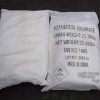- Metal Crafts[5]
- Carpet[10]
- Beach Chairs[10]
- Cooking Tool Sets[1]
- Cookware Sets[5]
- Hangers & Racks[3]
- Candy[10]
- Jackets[7]
- OEM Service[4]
- Stickers[5]
- Paper & Paperboard Printing[5]
- Packaging Boxes[1]
- Windmill[10]
- Auto Ignition System[2]
- Strollers[10]
- Christmas Decoration Supplies[2]
- Dishes & Plates[10]
- Mugs[10]
- Evening Bags[9]
- Fashion Accessories Design Services[2]
- Glass[10]
- Hot Melt Glue Sticks[7]
- Other Chemicals[4]
- Nitrate[1]
- PVC[1]
- Pendants & Charms[1]
- Bracelets & Bangles[1]
- Stone Crafts[1]
- Pottery & Enamel[1]
- Painting & Calligraphy[1]
- Contact Person : Mr. Li Dankle
- Company Name : Beijing Dakaile Import & Export Trading Co., Ltd.
- Tel : 86-10-84786263
- Fax : 86-10-84786263
- Address : Beijing,Beijing,Room 2709, Floor 23, Building 401, Wangjing Yuan, Chaoyang District
- Country/Region : China
Potassium Chlorate
Potassium chlorate is a compound containing potassium, chlorine and oxygen atoms, with the molecular formula KClO3. In its pure form, it is a white crystalline substance. It is the most common chlorate in industrial use. It is used
| Potassium chlorate | ≥99.5 |
| Moisture | ≤0.05 |
| Water insoluble matter | ≤0.03 |
| Chloride( as Cl ) | ≤0.02 |
| Bromate( as BrO3) | ≤0.01 |
| Sulfate( as SO4) | ≤0.003 |
| Fe | ≤0.003 |
| Residue on screen ( 125 µm test screen ) | ≤0.5 |
Potassium chlorate was one key ingredient in early firearms percussion caps (primers). It continues in that application, where not supplanted by potassium perchlorate.
Chlorate-based propellants are more efficient than traditional gunpowder and are less susceptible to damage by water. However, they can be extremely unstable in the presence of sulfur or phosphorus and are much more expensive. Chlorate propellants must be used only in equipment designed for them; failure to follow this precaution is a common source of accidents. Potassium chlorate, often in combination with silver fulminate[citation needed], is used in trick noise-makers known as "crackers", "snappers", "pop-its", or "bang-snaps", a popular type of novelty firework.
When mixed with a suitable fuel, it may form an explosive material, a so-called Sprengel explosive. The hygroscopic and slightly weaker sodium chlorate is sometimes used as a safer and less expensive substitute for potassium chlorate. In World War I, mixes of potassium chlorate with plasticizers (such as wax) were the most common type of plastic explosive used, often filling grenades and other munitions. When used in explosives as an oxidizer, the explosive is low order meaning it burns rapidly rather than explodes. When mixed with a plasticizer, it may become high order, requiring a blasting cap (generally a commercial #8) to detonate properly. Potassium chlorate is rarely used in explosives now, as it is considered too sensitive for most uses.
Potassium chlorate should be handled with care. It reacts vigorously, and in some cases spontaneously ignites or explodes, when mixed with many combustible materials. It will burn vigorously in combination with virtually any combustible material, even those which are considered to be only slightly flammable normally (including ordinary dust and lint). Mixtures of potassium chlorate and a fuel can be ignited by contact with sulfuric acid and this reagent should be kept away from potassium chlorate. Sulfur should be avoided in pyrotechnic compositions containing potassium chlorate, as these mixtures are prone to spontaneous deflagration. Most sulfur contains trace quantities of sulfur-containing acids, and these can cause spontaneous ignition - "Flowers of sulfur" or "sublimed sulfur", despite the overall high purity, contains significant amounts of sulfur acids. Also, mixtures of potassium chlorate with any compound with ignition promoting properties (ex. antimony(III) sulfide) are very dangerous to prepare, as they are extremely shock sensitive.
Potassium Chlorate




